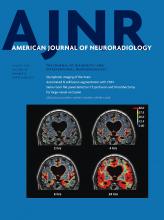Abstract
BACKGROUND AND PURPOSE: Diagnostic errors in radiology are classified as perception or interpretation errors. This study determined whether specific conditions differed when perception or interpretation errors occurred during neuroradiology image interpretation.
MATERIALS AND METHODS: In a sample of 254 clinical error cases in diagnostic neuroradiology, we classified errors as perception or interpretation errors, then characterized imaging technique, interpreting radiologist's experience, anatomic location of the abnormality, disease etiology, time of day, and day of the week. Interpretation and perception errors were compared with hours worked per shift, cases read per shift, average cases read per shift hour, and the order of case during the shift when the error occurred.
RESULTS: Perception and interpretation errors were 74.8% (n = 190) and 25.2% (n = 64) of errors, respectively. Logistic regression analyses showed that the odds of an interpretation error were 2 times greater (OR, 2.09; 95% CI, 1.05–4.15; P = .04) for neuroradiology attending physicians with ≤5 years of experience. Interpretation errors were more likely with MR imaging compared with CT (OR, 2.10; 95% CI, 1.09–4.01; P = .03). Infectious/inflammatory/autoimmune diseases were more frequently associated with interpretation errors (P = .04). Perception errors were associated with faster reading rates (6.01 versus 5.03 cases read per hour; P = .004) and occurred later during the shift (24th-versus-18th case; P = .04).
CONCLUSIONS: Among diagnostic neuroradiology error cases, interpretation-versus-perception errors are affected by the neuroradiologist's experience, technique, and the volume and rate of cases read. Recognition of these risk factors may help guide programs for error reduction in clinical neuroradiology services.
- © 2019 by American Journal of Neuroradiology







